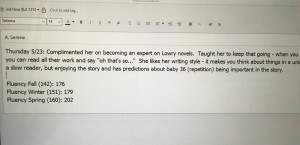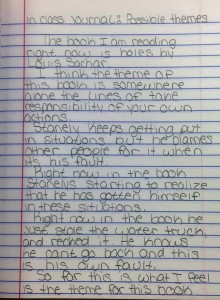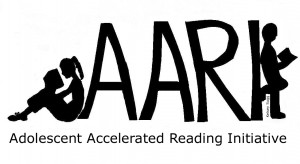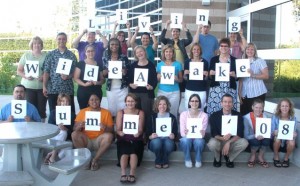Feedback is a part of every great formative assessment. And a lot has been written about how to give effective and meaningful feedback.
But nothing has solidified the effectiveness of meaningful feedback for me more than the daily conversations I now have with my two-and-a-half-year-old. She is constantly refining her understanding of syntax and semantics, solidifying her understanding of the world around her, and building her self-esteem–all through the words that we exchange.
These kinds of conversations with readers–hearing their thinking and asking them to clarify what they mean–help them in the moment of their understanding. Nothing is a more powerful tool for student learning and growth.
Conference Starting Points
Everything I learned about reading workshops and conferences started with Nancie Atwell and Lucy Calkins. They are the workshop gurus that you should turn to for all of your burning questions. But even if you aren’t ready to jump into a workshop, you can still use conferences in your classroom.
The basic structure of a reading conference is:
- Gather data about the reader
- Compliment the reader
- Teach the reader something new
- Jot notes about the reader’s thinking and how you pushed him/her; plan your follow up
In a conference, you can use questions to get at the heart of a reader’s confusion or difficulty:
- What questions do you have as you are reading?
- What in the text makes you think that?
- I noticed… I wonder…?
Depending on the student, I might have them read part of their book aloud to me, and then ask them a question. I may also read their response journal over their shoulder, and then ask them a question about it, or ask a big question (What is the theme of your book?). From here, I can scaffold if they aren’t getting to this (What are some of the important moments of your book? What are some things that the characters are learning?). In a conference, I can also look back at an exit ticket and ask students to clarify what they meant by something they wrote.
Logistics
In a good week, I could confer with five students a day. So I would usually allow myself two weeks to get to each student in a class. Sometimes I would have to make daily quick returns to those needy students until they got on track. So, three students a day, over the course of two weeks, is 30 students. This translates to 15 minutes of reading or independent practice that the other students are working on, while you make your rounds conferring with each student for three to five minutes.
While planning conferences, I would meet with students randomly. If there were a pattern, my students would become complacent. And I liked to keep them on their toes.
It’s important to note, too, that conferring has its own special way of keeping students on task. You are among the students. And your proximity to them makes them stay focused. You can move to different sides of the room between conferences, when you are taking notes, and therefore can quell whispers.
 Another benefit: your notes are a cheat sheet. Doctors take notes, in order to help them remember what they talked about, what’s happening in your personal history, and why you are there. Teachers can do the same thing. I’ve used a clipboard with student names, and I’ve also used my iPad with Evernote and a page for each student. (A sample note is listed on the left.)
Another benefit: your notes are a cheat sheet. Doctors take notes, in order to help them remember what they talked about, what’s happening in your personal history, and why you are there. Teachers can do the same thing. I’ve used a clipboard with student names, and I’ve also used my iPad with Evernote and a page for each student. (A sample note is listed on the left.)
Even if you aren’t using a workshop model, you can incorporate conferring with readers. (But, no matter the grade level you teach, you should really consider workshops! You can learn more about workshops HERE or HERE or HERE or HERE and especially HERE.) You can do so while students are working on whole-class novel reading or working on questions or starting their homework.
The Benefits
Conferring really helped me to become an effective teacher. I was connecting with students on a personal level and felt like I knew each and every one of them like never before. Students were also held accountable for their reading and thinking, and started to take more ownership over their own learning. And by meeting with students individually and then talking to the class as a whole group about emergent patterns and provocative statements, I was able to help connect readers and create community.
Caroline Thompson (@TeacherThompson) taught middle school ELA for 12 years in Lake Orion before becoming a stay-at-home mom. She supports AARI teachers for Oakland Schools as an independent literacy consultant in the areas of digital media, professional development, and non-fiction resources. Caroline is a Reading and Writing Workshop advocate, a 2008 Oakland Writing Project Teacher Consultant, and a 2009 Oakland County Outstanding Teacher of the Year Nominee. She has a BA in English from Michigan State University and a Masters in the Art of Teaching Reading from Oakland University. She lives in Berkley with her husband and their 2-and-a-half-year-old daughter.




 Now that I’ve covered the
Now that I’ve covered the  are probably not a struggling reader. But you probably have struggled with learning something new or tackling something difficult. You could try something new, or bring in your graduate school work and explain what is difficult for you–anything to show that improvement takes time, practice, and strategies to succeed.
are probably not a struggling reader. But you probably have struggled with learning something new or tackling something difficult. You could try something new, or bring in your graduate school work and explain what is difficult for you–anything to show that improvement takes time, practice, and strategies to succeed. Even if your group of struggling readers is blossoming, it’s important to consider how your community can continue to grow and thrive. That’s especially true for classrooms organized around the
Even if your group of struggling readers is blossoming, it’s important to consider how your community can continue to grow and thrive. That’s especially true for classrooms organized around the  Break bread together. One Friday a month, my classes would have what came to be known as “Food Fridays.” It usually started with my bringing in some snacks (think Costco/Sam’s Club granola bars or crackers). Some years, it took on a life of its own. Students would initiate elaborate sign-up sheets, and they would bake brownies and frost cupcakes. Other years, the kids were just happy to have a little something to eat while we worked.
Break bread together. One Friday a month, my classes would have what came to be known as “Food Fridays.” It usually started with my bringing in some snacks (think Costco/Sam’s Club granola bars or crackers). Some years, it took on a life of its own. Students would initiate elaborate sign-up sheets, and they would bake brownies and frost cupcakes. Other years, the kids were just happy to have a little something to eat while we worked. Oakland Writing Project’s
Oakland Writing Project’s